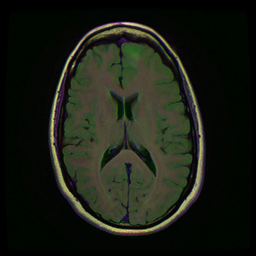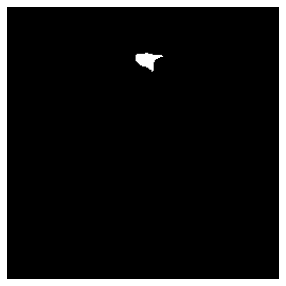In this tutorial, I will be looking at how to prepare a semantic segmentation dataset for use with FastAI. I will be using the Chest X-Ray Images (Pneumonia) dataset from Kaggle as an example. This post focuses on the components that are specific to semantic segmentation. To see tricks and tips for using FastAI with data in general, see my FastAI Data Tutorial - Image Classification.
Table of Contents
from fastai.vision.all import *
path = Path('/home/julius/data/kaggle/lgg-mri-segmentation/kaggle_3m/')
def get_images(path):
all_files = get_image_files(path)
images = [i for i in all_files if 'mask' not in str(i)]
return images
def get_label(im_path):
return im_path.parent / (im_path.stem + '_mask' + im_path.suffix)
all_images = get_images(path)
examp_im_path = all_images[0]
examp_im_path
Path('/home/julius/data/kaggle/lgg-mri-segmentation/kaggle_3m/TCGA_DU_7309_19960831/TCGA_DU_7309_19960831_21.tif')
im = PILImage.create(examp_im_path)
im

mask = PILImage.create(get_label(examp_im_path))
mask.show(figsize=(5,5), alpha=1)
<AxesSubplot:>

mask.shape
(256, 256)
codes = ['n', 'y']
bs=16
Now we determine which blocks to use. For segmentation tasks, we’ll generally use MaskBlock.
blocks = (ImageBlock, MaskBlock(codes))
Now we create the DataBlock.
dblock = DataBlock(blocks = blocks,
get_items = get_images,
get_y = get_label,
splitter = RandomSplitter(),
item_tfms = Resize(224))
dblock.summary(path)
Setting-up type transforms pipelines
Collecting items from /home/julius/data/kaggle/lgg-mri-segmentation/kaggle_3m
Found 3929 items
2 datasets of sizes 3144,785
Setting up Pipeline: PILBase.create
Setting up Pipeline: get_label -> PILBase.create
Setting up Pipeline: PILBase.create
Setting up Pipeline: get_label -> PILBase.create
Building one sample
Pipeline: PILBase.create
starting from
/home/julius/data/kaggle/lgg-mri-segmentation/kaggle_3m/TCGA_DU_7304_19930325/TCGA_DU_7304_19930325_14.tif
applying PILBase.create gives
PILImage mode=RGB size=256x256
Pipeline: get_label -> PILBase.create
starting from
/home/julius/data/kaggle/lgg-mri-segmentation/kaggle_3m/TCGA_DU_7304_19930325/TCGA_DU_7304_19930325_14.tif
applying get_label gives
/home/julius/data/kaggle/lgg-mri-segmentation/kaggle_3m/TCGA_DU_7304_19930325/TCGA_DU_7304_19930325_14_mask.tif
applying PILBase.create gives
PILMask mode=L size=256x256
Final sample: (PILImage mode=RGB size=256x256, PILMask mode=L size=256x256)
Collecting items from /home/julius/data/kaggle/lgg-mri-segmentation/kaggle_3m
Found 3929 items
2 datasets of sizes 3144,785
Setting up Pipeline: PILBase.create
Setting up Pipeline: get_label -> PILBase.create
Setting up Pipeline: PILBase.create
Setting up Pipeline: get_label -> PILBase.create
Setting up after_item: Pipeline: AddMaskCodes -> Resize -- {'size': (224, 224), 'method': 'crop', 'pad_mode': 'reflection', 'resamples': (2, 0), 'p': 1.0} -> ToTensor
Setting up before_batch: Pipeline:
Setting up after_batch: Pipeline: IntToFloatTensor -- {'div': 255.0, 'div_mask': 1}
Building one batch
Applying item_tfms to the first sample:
Pipeline: AddMaskCodes -> Resize -- {'size': (224, 224), 'method': 'crop', 'pad_mode': 'reflection', 'resamples': (2, 0), 'p': 1.0} -> ToTensor
starting from
(PILImage mode=RGB size=256x256, PILMask mode=L size=256x256)
applying AddMaskCodes gives
(PILImage mode=RGB size=256x256, PILMask mode=L size=256x256)
applying Resize -- {'size': (224, 224), 'method': 'crop', 'pad_mode': 'reflection', 'resamples': (2, 0), 'p': 1.0} gives
(PILImage mode=RGB size=224x224, PILMask mode=L size=224x224)
applying ToTensor gives
(TensorImage of size 3x224x224, TensorMask of size 224x224)
Adding the next 3 samples
No before_batch transform to apply
Collating items in a batch
Applying batch_tfms to the batch built
Pipeline: IntToFloatTensor -- {'div': 255.0, 'div_mask': 1}
starting from
(TensorImage of size 4x3x224x224, TensorMask of size 4x224x224)
applying IntToFloatTensor -- {'div': 255.0, 'div_mask': 1} gives
(TensorImage of size 4x3x224x224, TensorMask of size 4x224x224)
/home/julius/miniconda3/envs/fai/lib/python3.8/site-packages/torch/_tensor.py:575: UserWarning: floor_divide is deprecated, and will be removed in a future version of pytorch. It currently rounds toward 0 (like the 'trunc' function NOT 'floor'). This results in incorrect rounding for negative values.
To keep the current behavior, use torch.div(a, b, rounding_mode='trunc'), or for actual floor division, use torch.div(a, b, rounding_mode='floor'). (Triggered internally at /opt/conda/conda-bld/pytorch_1623448234945/work/aten/src/ATen/native/BinaryOps.cpp:467.)
return torch.floor_divide(self, other)
dls = dblock.dataloaders(path)
dls.train.show_batch(max_n=4, nrows=1)
